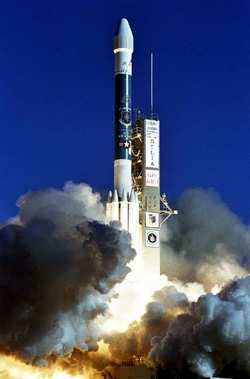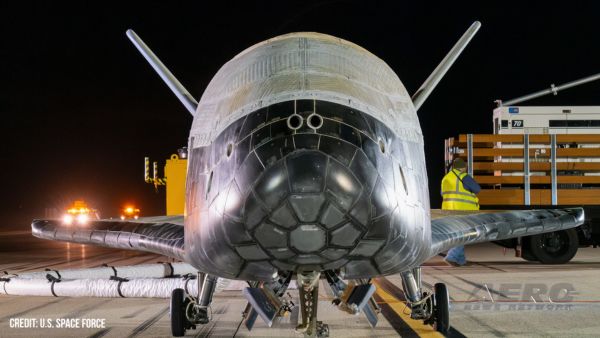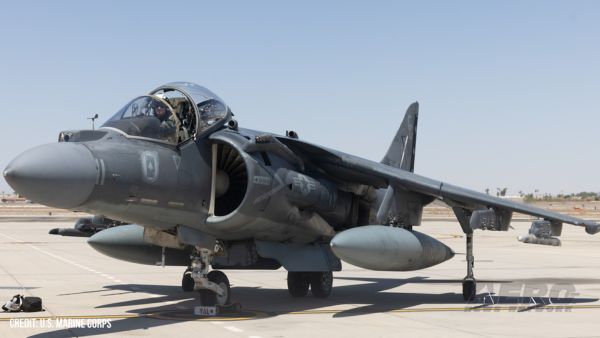Tue, Mar 24, 2009
First Delta II Launch Was Also A GPS Flight
 A United Launch Alliance Delta II rocket successfully launched
the Air Force's Global Positioning Satellite IIR-20(M) into orbit
from Cape Canaveral's Space Launch Complex 17A at 4:34 am EDT. This
was the 47th successful GPS launch for the Delta II in its storied
20-year history.
A United Launch Alliance Delta II rocket successfully launched
the Air Force's Global Positioning Satellite IIR-20(M) into orbit
from Cape Canaveral's Space Launch Complex 17A at 4:34 am EDT. This
was the 47th successful GPS launch for the Delta II in its storied
20-year history.
The very first Delta II launch on February 14, 1989 was the
NAVSTAR II-1 launch. NAVSTAR is now commonly known as GPS.
Following a nominal 1 hour and 8 minute flight, the rocket
deployed the GPS IIR-20(M) spacecraft, the seventh modernized
NAVSTAR Global Positioning System Block II R-M military navigation
satellite. GPS is a space-based positioning system designed and
operated as a 24-satellite constellation that provides precision
navigation and timing information to military and civilian users
worldwide.
"Congratulations to the Air Force and all of our mission
partners on today's successful GPS satellite launch," said Jim
Sponnick, vice president, Delta Product Line. "One third of the 140
successful Delta II launches have been dedicated to GPS satellites.
The ULA Delta team is extremely proud of the role we've played in
launching this incredible satellite constellation. During the past
two decades, GPS has changed how people navigate around their
neighborhoods and around the globe. GPS has also greatly improved
military operations as well as numerous maritime, aircraft, and
business operations worldwide."
Designed to operate for 10 years, GPS satellites orbit the Earth
every 12 hours, emitting continuous navigation signals. With the
proper equipment, users can receive these signals to calculate
time, location and velocity. In addition to its military use, GPS
satellites provide directional assistance to civilian users around
the world.
The ULA Delta II 7925-9.5 configuration vehicle featured an ULA
first stage booster powered by a Pratt & Whitney Rocketdyne
RS-27A main engine and nine Alliant Techsystems (ATK) strap-on
solid rocket motors. An Aerojet AJ10-118K engine powered the second
stage. A spin-stabilized Star-48B solid-rocket motor built by ATK
boosted the third stage. The payload was encased by a
9.5-foot-diameter metallic payload fairing.
ULA's next launch is the Air Force Wideband Global SATCOM-2
mission scheduled aboard an Atlas V from SLC-41 at Cape Canaveral.
A specific launch date has not been established.
More News
“This Russian activity in the Alaskan ADIZ occurs regularly and is not seen as a threat.” Source: From an email release from Canadian Armed Forces Capt. Rebecca Garand,>[...]
Terminal Radar Service Area Airspace surrounding designated airports wherein ATC provides radar vectoring, sequencing, and separation on a full-time basis for all IFR and participa>[...]
From 2016 (YouTube Edition): Upgrades For Your 182… Sun ‘n Fun 2016 presented the opportunity to see some really interesting things, and a hopped-up Cessna 182 on floa>[...]
Airplane’s Encounter With A Dust Devil, Which Resulted In A Loss Of Airplane Control At A Low Altitude Analysis: The pilot reported that while conducting a slow flight maneuv>[...]
Aero Linx: International Fellowship of Flying Rotarians IFFR is one of the oldest Rotary Fellowships and was formally established through the efforts of a dedicated Rotarian, E. Ed>[...]
 Aero-News: Quote of the Day (08.24.25)
Aero-News: Quote of the Day (08.24.25) ANN's Daily Aero-Term (08.24.25): Terminal Radar Service Area
ANN's Daily Aero-Term (08.24.25): Terminal Radar Service Area Classic Aero-TV: Goes Like Heck! - Wipaire's Boss 182 Amphibious Conversion
Classic Aero-TV: Goes Like Heck! - Wipaire's Boss 182 Amphibious Conversion NTSB Final Report: Quicksilver MX II
NTSB Final Report: Quicksilver MX II ANN's Daily Aero-Linx (08.24.25)
ANN's Daily Aero-Linx (08.24.25)



